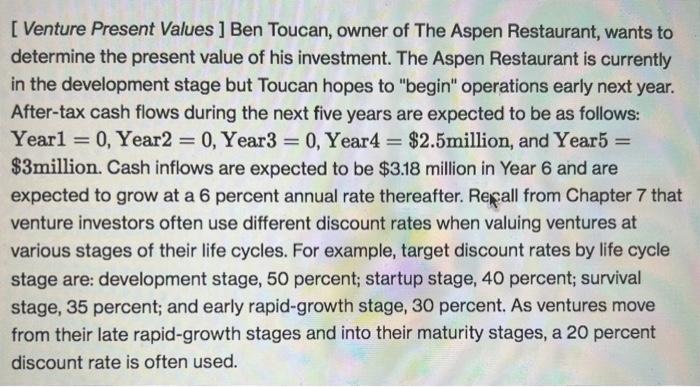Answered step by step
Verified Expert Solution
Question
1 Approved Answer
a. Terminal value at t=5 assuming maturity stage t=6 in perpetuity? b. Present vlue of TV assuming development stage ar t=1 to t=5 c. PV
a. Terminal value at t=5 assuming maturity stage t=6 in perpetuity?
= [ Venture Present Values ] Ben Toucan, owner of The Aspen Restaurant, wants to determine the present value of his investment. The Aspen Restaurant is currently in the development stage but Toucan hopes to "begin" operations early next year. After-tax cash flows during the next five years are expected to be as follows: Yearl = 0, Year2 = 0, Year3 = 0, Year4 = $2.5million, and Year5 = -0 $ $3million. Cash inflows are expected to be $3.18 million in Year 6 and are expected to grow at a 6 percent annual rate thereafter. Repall from Chapter 7 that venture investors often use different discount rates when valuing ventures at various stages of their life cycles. For example, target discount rates by life cycle stage are: development stage, 50 percent; startup stage, 40 percent; survival stage, 35 percent; and early rapid-growth stage, 30 percent. As ventures move from their late rapid-growth stages and into their maturity stages, a 20 percent discount rate is often used. = [ Venture Present Values ] Ben Toucan, owner of The Aspen Restaurant, wants to determine the present value of his investment. The Aspen Restaurant is currently in the development stage but Toucan hopes to "begin" operations early next year. After-tax cash flows during the next five years are expected to be as follows: Yearl = 0, Year2 = 0, Year3 = 0, Year4 = $2.5million, and Year5 = -0 $ $3million. Cash inflows are expected to be $3.18 million in Year 6 and are expected to grow at a 6 percent annual rate thereafter. Repall from Chapter 7 that venture investors often use different discount rates when valuing ventures at various stages of their life cycles. For example, target discount rates by life cycle stage are: development stage, 50 percent; startup stage, 40 percent; survival stage, 35 percent; and early rapid-growth stage, 30 percent. As ventures move from their late rapid-growth stages and into their maturity stages, a 20 percent discount rate is often used b. Present vlue of TV assuming development stage ar t=1 to t=5
c. PV of cash flows assuming development stage t=1 to t=5
d. Ownerhsip %
e. Ownership% assuming startup stage t=1 to t=5 

Step by Step Solution
There are 3 Steps involved in it
Step: 1

Get Instant Access to Expert-Tailored Solutions
See step-by-step solutions with expert insights and AI powered tools for academic success
Step: 2

Step: 3

Ace Your Homework with AI
Get the answers you need in no time with our AI-driven, step-by-step assistance
Get Started


